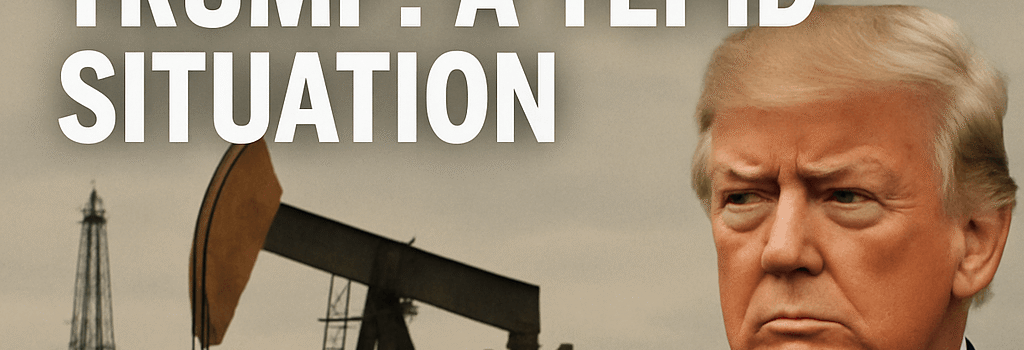U.S. Oil and Gas Output Under Trump: A Tepid Situation

President Donald Trump arrived at his second inauguration promising a seismic upswing in domestic oil and gas production. Echoing the campaign rally cry of drill, baby, drill the administration has pursued aggressive deregulation, royalty reductions on public lands, and rolled back major environmental safeguards. Yet six months in, rig counts remain near four-year lows and crude exports lag year ago levels. Here we dive deeper into the technical, economic, and strategic factors limiting a true drilling boom.
Current Production and Rig Count Trends
On January 20 the United States counted 580 active rigs, as reported weekly by Baker Hughes. As of late July the figure stands at 542 rigs. That level is barely above the four-year trough reached earlier this month. Despite incremental upticks in Permian Basin output and targeted lease sales in the Bakken and Eagle Ford plays, overall drilling activity has not accelerated as anticipated.
- West Texas Intermediate average price: near 68 dollars per barrel in late July
- Break-even for new shale wells: approximately 60 dollars per barrel
- Baker Hughes rig count change: down 6.5 percent since inauguration
- Monthly crude exports Apr–Jul 2025: three percent below same period in 2024
Global Market Dynamics
Oil is traded on a global spot market where domestic policy plays a secondary role. Two major factors constrain U.S. producers today.
- OPEC+ Supply Management. Under a production accord led by Saudi Arabia and Russia, OPEC+ has maintained quotas that keep crude prices in the mid 60s range. The cartel has signaled potential output increases if global demand recovers further in late 2025.
- Flatening Demand in China. China, the world’s top oil consumer, has reduced its refinery runs amid an industrial slowdown. Lower Chinese imports have created a supply overhang impacting WTI and Brent benchmarks.
Impact of Electric Power Demand and AI Data Centers
Fast-growing electricity consumption from data centers running AI workloads has boosted national power demand by over 4 percent year over year. This surge drives up fuel-switching between natural gas and coal but has not yet translated into significant upstream drilling for liquids-rich assets. Companies remain cautious until long-term electricity prices and carbon regulations stabilize.
Technological Innovations in Modern Drilling
Despite policy incentives, several technological and operational trends dampen the rush to spud new wells.
- Advanced Well Completions. Operators now favor longer laterals with ultra-high-pressure multi-stage fracs using 20 million pounds of frac sand per well. While this boosts individual well productivity by up to 30 percent, it also raises completion costs to roughly 8 million dollars per well.
- Automation and Digital Oilfields. Remote drilling controls, downhole sensors, and digital twins improve efficiency but require upfront capex investments. Many E&P firms are focusing capex on optimizing existing wells instead of greenfield drilling.
- Electrified Drilling Rigs. Pilot programs in the Permian have deployed electric top drives and battery buffers to cut diesel consumption by 15 percent and methane venting by 20 percent. These systems are still in validation stages and not yet widely adopted.
Tariffs, Royalties, and Regulatory Volatility
It is hard to imagine how much worse policies and DC rhetoric could have been for US E&P companies
—E&P executive, Federal Reserve Dallas survey June 2025
Many producers import steel tubulars and drill bits from Asia and Europe. With steel tariff surcharges near 25 percent, equipment costs have spiked. The recently enacted One Big Beautiful Bill Act mandates lease sales and cuts federal royalties from 16.67 to 12.5 percent. But executives warn that the combined effect of lower royalties and higher tariff bills compresses netbacks.
Investment Strategies and Lease Holdings
Major oil companies and independents adopt a hold-and-wait strategy. Under existing law, companies can bid on lease tracts and defer drilling for up to 10 years while paying minimal holding fees. This approach allows firms to secure acreage in the Permian, Anadarko, and offshore Gulf of Mexico and await more favorable price environments.
According to ClearView Energy Partners, industry participants anticipate a potential rebound in late 2026 if global supply tightens. Until then, capex discipline prevails. Operators are reallocating funds to high-graded core areas and secondary recovery in mature fields rather than frontier drilling.
Climate Implications and Renewable Competition
The rollback of EPA methane flaring rules and removal of wind and solar tax incentives undercuts renewables’ growth. Yet the levelized cost of electricity from onshore wind has fallen below 30 dollars per MWh and solar to 25 dollars per MWh in prime regions. A recent United Nations report reaffirms that solar and wind remain the fastest and cheapest additions to generation portfolios.
Texas now leads the nation in both wind output and new solar capacity installations, underscoring the paradox of a state renowned for oil also driving America’s clean energy expansion.
Additional Analysis
Supply Chain Resilience
Energy contractors are diversifying supply chains for steel, fracturing chemicals, and specialty alloys to mitigate tariff risks. Some are repurposing domestic mills and forging partnerships with Canadian suppliers under NAFTA provisions. Yet lead times for high-pressure tubular goods can exceed 60 days, influencing project scheduling.
Financing and ESG Pressure
Major banks and institutional investors have tightened financing for high-carbon projects. Debt terms for new drilling pipelines now often include emissions reduction covenants. Green bond frameworks are emerging for companies pledging to electrify frac fleets and cut methane intensity below 0.2 percent of production volumes.
Looking Ahead
Six months may be a short window to judge a full policy shift in oil and gas. Technology investments, global market forces, and capital allocation trends all point to continued drill count discipline. Should OPEC+ ease quotas or Chinese demand recover, the U.S. industry is primed to ramp up rapidly—but only when prices clear the economic hurdle and regulatory stability is assured.